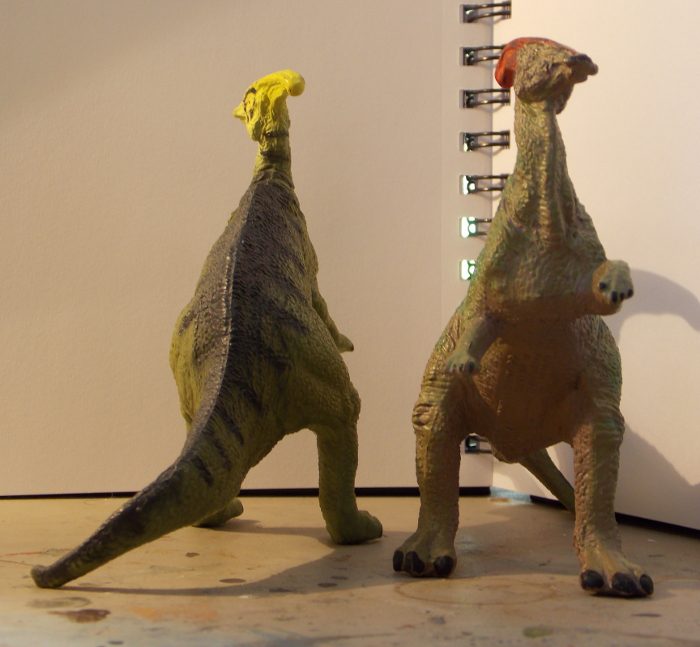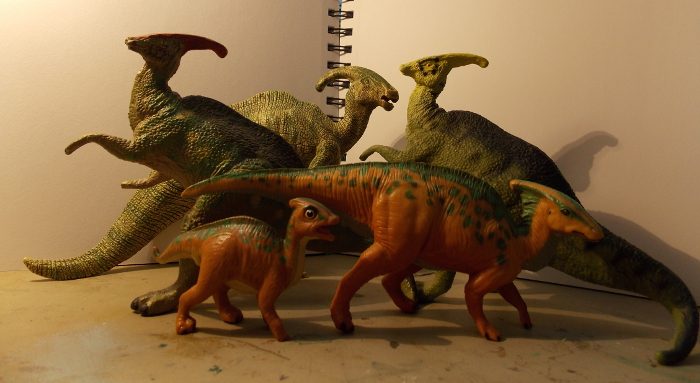Review and photographs by Quentin Brendel (aka Pachyrhinosaurus), edited by Suspsy
Perhaps the most well-recognized ornithopod, Parasaurolophus is included in nearly every dinosaur toy line. It was part of the original starting lineup of the legendary Carnegie Collection. In fact, the Carnegie Parasaurolophus was one of only five models released in 1988 to have remained relatively unchanged until the extinction of the Carnegie line in 2015. Through its lengthy tenure, the Carnegie Parasaurolophus has gone through different versions. The two to be featured in this review are the 1996-2007 and the 2007-2015 versions. Before 1996, this dinosaur was rounder and less well-defined, sporting a straighter neck and glossier paint.

The Carnegie Parasaurolophus is in a tripod stance, perhaps rearing up to feed or to look for predators. The head and neck are tilted backwards which could also insinuate alertness or browsing. The entire figure, though most noticeably in the head and neck region, is covered with intricate detail including skin folds and scales. The scales are probably too large considering how small they would have been in life, but smaller scales are much more difficult to sculpt at such a small scale. Forest Rogers did a very nice job with the wrinkles and folds in the neck. They convey a good sense of movement, as though the neck really is flexed upwards.

The earlier version of the figure is painted in a solid green with medial black stripes leading up to a bright yellow head, which sports black markings of its own and surprisingly, red eyes. It appears that the paint job is to depict the head as a point of visual display. Even though the transitions are naturalistic, the colors are still relatively flat, and could have been improved. 2007 brought with it quite a few repaints of classic Carnegie dinosaurs. Among them, was a new Parasaurolophus. The new paint job is much more complicated than that of its predecessor. The new paint is on a light brown color base material. Most of it is in varying shades of green, which is most vibrant over the sides, overlapped by yellow spots. The green colour becomes less intense as it nears the ventral surface, allowing for the base color to show through for a brown underside. The dorsal surface is painted with a darker green with very faint medial stripes (perhaps as a reference to the older color scheme?). The darker green was applied thinly as to allow the medium green to appear through the high spots. The head is largely free of green (save for a tiny accent near the bill) and is painted with dark brown with the lighter brown showing in the low areas. The crest is a dark red, which is found nowhere else on the figure. The eyes are yellow this time, and while they’re closer, they still aren’t the typical Carnegie gold.

In length, this model is about six-and-a-half inches long straight from bill to tail to tail tip. The bottom of one of my newer figures reads 1:50. Interestingly, it is only on one of my post-2007 figures, which, according to the production date stamp, was made in August of 2013, while my older one was made before Safari started stamping dates on their figures. The other three are stamped “10 METERS”. All four have 1988 on them.

Despite a few anatomical errors, the figure was probably up-to-date at the time of its introduction to the market. Proportionally, it’s almost perfect except for the length of the tail, which is just a smidge shorter than it should be. The forelimbs look a bit small from a distance, however, when compared to a skeleton, they are right in scale with the rest of the body. Even the spinal ridge, with the dip in the middle, is true to the actual animal. After that, though, there seems to be a dip at the base of the tail which is not in the actual dinosaur, but that’s probably due to the strange posture the figure has in order to have support from its tail. The hands show four claws on each. I don’t know as much as I’d like to about hadrosaur hands, but it appears as though the number of digits- four- is correct, but it is now recognized that they should be bound together in more of a hoof-like structure, with three digits on the ground and one held off the ground. The hands on the Carnegie Parasaurolophus look more suitable for a more basal, bipedal ornithopod, but that’s probably just a sign of the times, since hadrosaurs were once viewed as animals which were both quadrupedal and bipedal. More recently it was thought that they were facultative bipeds, but some have suggested that it would not be practical for a hadrosaur to take to bipedal running.

Even though this figure isn’t completely up-to-date, I would recommend the Carnegie Parasaurolophus to any dinosaur enthusiast. It’s a nice figure (if it weren’t, I wouldn’t have bought four of them) and even though the Carnegie Collection has come to an end, it can still be found on eBay and elsewhere for a reasonable price.

Support the Dinosaur Toy Blog by making dino-purchases through these links to Ebay and Amazon. Disclaimer: links to Ebay.com and Amazon.com on the Dinosaur Toy Blog are often affiliate links, when you make purchases through these links we may make a commission

This was one of my favorite dinosaur toys when I was younger – I got the little yellowhead at a “Dinosaurs Alive!” show back in the 90’s. I need to pick up another sometime for nostalgia’s sake.